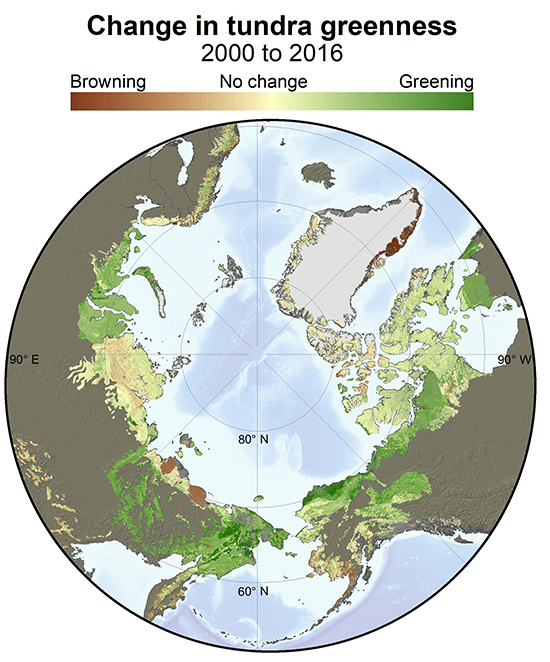As Arctic summers warm, Earth’s northern landscapes are changing. Using satellite images to track global tundra ecosystems over decades, a new study found the region has become greener, as warmer air and soil temperatures lead to increased plant growth.
–These types of studies, in which we pool detailed datasets from respective partners spread throughout the world, help us to better synthesise otherwise disparate findings to understand what is happening across the entire circumpolar North. The big picture that greening is not consistent among different regions raises questions we need to ask next regarding drivers and feedbacks, says research professor Bruce Forbes from Arctic Centre, University of Lapland.
His team has provided detailed ground-level baseline data on annual growth of tundra shrubs in relation to climate, i.e. dendroclimatology, at sites in West Siberia and northernmost Fennoscandia.
–The Arctic tundra is one of the coldest biomes on Earth, and it’s also one of the most rapidly warming, said Logan Berner, a global change ecologist with Northern Arizona University in Flagstaff, who led the recent research. –This Arctic greening we see is really a bellwether of global climatic change – it’s this biome-scale response to rising air temperatures.
The study, published this week in Nature Communications, is the first to measure vegetation changes across the Arctic tundra, from Alaska and Canada to Siberia, using satellite data from Landsat, a joint mission of NASA and the U.S. Geological Survey. Landsat data can be used to determine how much actively growing vegetation is on the ground – greening can represent plants growing more, becoming denser, or shrubs encroaching on typical tundra grasses and moss.
When the tundra vegetation changes, it impacts not only the wildlife that depend on the certain plants, but also the people who live in the region and depend on local ecosystems for food. While active plants will absorb more carbon from the atmosphere, the warming temperatures could also be thawing permafrost, releasing greenhouse gasses. The research is part NASA’s Arctic Boreal Vulnerability Experiment (ABoVE), which aims to better understand how ecosystems are responding in these warming environments and its broader implications.
Berner and his colleagues used the Landsat data and additional calculations to estimate the peak greenness for a given year for each of 50,000 randomly selected sites across the tundra. Between 1985 and 2016, about 38% of the tundra sites across Alaska, Canada, and western Eurasia showed greening. Only 3% showed the opposite browning effect, which would mean fewer actively growing plants. To include eastern Eurasian sites, they compared data starting in 2000, since that’s when Landsat satellites began collecting regular images of that region. With this global view, 22% of sites greened between 2000 and 2016, while 4% browned.

More information:
Bruce Forbes
Research professor
Arctic Centre, University of Lapland
bruce.forbes(at)ulapland.fi
+35840 847 9202
NASA press release: Warming Temperatures are Driving Arctic Greening